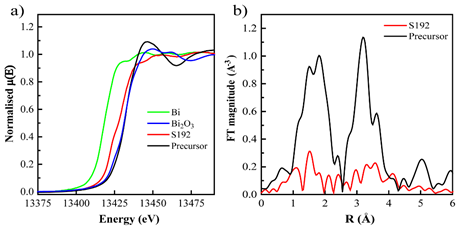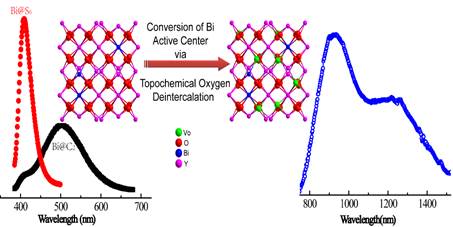| Unconventional Luminescent Centers in Metastable Phases Created by Topochemical Reduction Reactions |
| From: PublishDate:2017-06-16 Hits: |
Luminescent materials containing bismuth and emitting in the near-infrared (NIR) spectral region have attracted much interest owing to a broad range of applications such as lasers, bioimaging, and telecommunications. However, it is extremely difficult to realize the rational synthesis of bismuth-activated, near-infrared luminescent materials. Concurrently, the near-infrared luminescence mechanism of such systems remains poorly understood. A team from College of Chemistry, Chemical Engineering and Materials Science of Soochow University has found a novel generic approach to convert Bi-activated visible emitters to those emitting in the NIR region, and made progress in understanding the nature of Bi-related NIR active centers. Their research has been published on March 11th, 2016 in Angewandte Chemie International Edition. The team has shown that the low-temperature topochemical reduction strategy can be employed as a powerful method for the synthesis of unconventional phosphors with luminescence covering the biological and/or telecommunication optical windows. Additionally, they have found that this low-temperature topochemical reduction strategy can be readily extended to the manipulation of PL from other classes of Bi-doped compounds. XANES and EXAFS analyses suggest that the topochemical reduction leads to the evolution of [BiO6] octahedra in Y1.992Bi0.008O3 to [BiO6-z] (z<6) polyhedra in reduced phases, resulting in a reduction in the average oxidation states of Bi present. The team confirmed that the change of Bi coordination environments is the reason for the shift of the PL band maxima from the visible to the NIR spectral region.
Figure 1. Bi LIII-edge XANES and EXAFS spectra of the precursor and oxygen-deficient sample. The X-ray absorption spectra were obtained from BSRF. The result shows that topochemical reduction results in the formation of under-coordinated Bi-O polyhedra in the reduced phase (S192) with respect to the precursor.
Figure 2. Schematic of the topochemical treatment of BiIII-doped Y2O3. CaH2 treatment of BiIII-doped Y2O3 (Y2-xBixO3) creates randomly distributed oxygen vacancies in the matrix, leading to lowered oxidation states for the Bi centers and a change in the emission profile of the material.
This is the first report on the rational manipulation of PL from typical Bi3+ emitters to those emitting in the NIR region, greatly deepening the understanding of Bi-related photophysical behaviors. BSRF have helped the team to unveil the local environment of unconventional emitters. “we highlight this approach as a sufficiently general route for the manipulation of PL in other compounds, thereby opening up new avenues to develop novel luminescent systems that may be promising for a diverse array of functional applications. We anticipate that this low temperature topochemical route can be extended to tune the properties of other types of optoelectronic materials, and synchrotron beams will guide us forward.” explains Hong-Tao Sun, the team leader and the professor of College of Chemistry, Chemical Engineering and Materials Science, Soochow University. Article: Bo-Mei Liu, Zhi-Gang Zhang, Kai Zhang, Yoshihiro Kuroiwa, Chikako Moriyoshi, Hui-Mei Yu, Chao Li, Li-Rong Zheng, Li-Na Li, Guang Yang, Yang Zhou, Yong-Zheng Fang, Jing-Shan Hou, Yoshitaka Matsushita, Hong-Tao Sun*. Unconventional Luminescent Centers in Metastable Phases Created by Topochemical Reduction Reactions. Angewandte Chemie International Edition 55.16 (2016): 4967-4971 . |
|
|
| Chinese
- Metal-free efficient photocatalyst for stable visible water splitting——Top ten major scientific progresses in China in 2015
- The nano-resolution imaging platform was awarded the first rate prize of Beijing Science and Technology in 2014
- Beamline 1W1 of BSRF started to runoperate in the couplingparasitic mode of BEPCII
- Synthesis of High Performance Polymer Materials for Field Effect-Transistors
- Surfactant molecular aggregates in green solvents
- GIXRD has played an important role in the characterization of organic thin-film transistors
Copyright © 2011 - 2012 Beijing Synchrotron Radiation Facility



